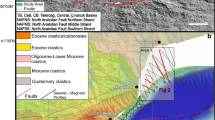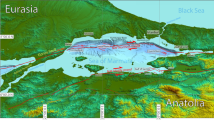Abstract
Profiles across subduction-related trenches commonly show normal faulting of the outer trench wall. Such faulting is generally parallel or sub-parallel to the trench and is ascribed to tension in the upper part of the oceanic plate as it is bent into the subduction zone. A number of authors have noted that outer trench wall faulting may involve re-activation of the oceanic spreading fabric of the subducting plate, even when the trend of this fabric is noticeably oblique to the extensional stress direction. However, one previous review of outer trench wall fault patterns questioned the occurrence of a consistent link between fault orientation and such controlling factors. This latter study predated the widespread availability of swath bathymetry and longrange sidescan sonar data over trenches. Based only on profile data, it was unable to analyse fault patterns with the accuracy now possible. This paper therefore re-examines the relationship between outer trench wall faulting and the structure of the subduction zone and subducting plate using GLORIA and Seabeam swath mapping data from several locations around the Pacific and Indian Oceans. The principal conclusions is that the trend of outer trench wall faults is almost always controlled by either the subducting slab strike or by the inherited oceanic spreading fabric in the subducting plate. The latter control operates when the spreading fabric is oblique to the subducting slab strike by less than 25–30°; in all other cases the faults are parallel to slab strike (and parallel or sub-parallel to the trench). Where the angle between spreading fabric and slab strike is close to 30°, two fault trends may coexist; evidence from the Aleutian Trench indicates a gradual change from spreading fabric to slab strike control of fault trend as the angle between the two increases from 25 to 30°. The only observed exception to the above ‘rule’ of fault control comes from the western Aleutian Trench, where outer trench wall faults are oblique to the slab strike, almost perpendicular to the spreading fabric, and parallel to the convergence direction. Re-orientation of the extensional stress direction due to right-lateral shear at this highly oblique plate boundary is the best explanation of this apparently anomalous observation.
Similar content being viewed by others

References
AAPG, 1982, Plate Tectonic Maps of the Circum-Pacific Region. Amer. Assoc. Petroleum Geol., Tulsa, Oklahoma.
AAPG, 1984, Geodynamic Maps of the Circum-Pacific Region. Amer. Assoc. Petroleum Geol., Tulsa, Oklahoma.
Aubouin, J., Stephen, J.-F., Renard, V., Roump, J. and Lonsdale, P., 1982, a Seabeam Survey of the Leg 67 Area (Middle American Trench off Guatemala) in AubouinJ., vonHueneR. et al. (eds.), Initial Reports Deep Sea Drilling Project, 67. U.S. Government Printing Office, Washington, D.C., pp. 733–738.
Aubouin, J., Bourgois, J., and Azema, J., 1984, A New Type of Active Margin: The Convergent-Extensioanl Margin, as Exemplified by the Middle America Trench Off Guatemala, Earth Planet. Sci. Lett. 67, 211–218.
Barazangi, M. and Isacks, B. L., 1976, Spatial Distribution of Earthquakes and Sudduction of the Nazca Plate Beneath South America, Geology 4, 686–692.
Cadet, J.-P., Kobayashi, K., Aubouin, J., Boulegue, J., Deplus, C., Dubois, J., vonHuene,R., Jolivet, L., Kanazawa, T., Kasahara, J., Koizumi, K., Lellemand, S., Nakamura, Y., Pautot, G., Suyehiro, K., Tani, S., Hidekazu, T., and Yamazaki, T., 1987, The Japan Trench and its Juncture with the Kuril Trench: Cruise Results of the Kaiko Project, Leg 3. Earth Planet. Sci. Letters 83, 267–284.
Heirtzler, J. R., Cameron, P., Cook, P. J., Powell, T., Roeser, M. A., Sukardi, S., and Veevers, J. J., 1978, The Argo Abyssal Plain, Earth Planet. Sci. Letters 41, 21–31.
Hey, R. N., 1977, A new class of ‘pseudofault’ and their bearing on plate tectonics: a propagating rift model, Earth Planet. Sci. Letters 37, 321–325.
Hilde, T. W. C., 1983, Sediment Subduction versus Accretion Around the Pacific, Tectonophysics 99, 381–397.
Jones, G. M., Hilde, T. W. C., Sharman, G. F., and Agnew, D. C., 1978, Fault Patterns in Outer Trench Walls, J. Phys. Earth 26, suppl. S85-S101.
Kaiko 1 Research Group, 1986, Topography and Structure of Trenches Around Japan—Data Atlas of Franco-Japanese Kaiko project, phase 1, Ocean Res. Institute, Tokyo and IFRE-MER, Paris.
Klitgord, K. D. and Mammerickx, J., 1982, Northern East Pacific Rise: Magnetic Anomaly and Bathymetric Framework, J. Geophys. Res. 87, 6725–6750.
Kobayashi, K., Cadet, J.-P., Aubouin, J., Boulegue, J., Dubois, J., vonHuene, R., Jolivet, L., Kanazawa, T., Kasahara, J., Koizumi, K., Lallemand, S., Nakamura, Y., Pautot, G., Suyehiro, K., Tani, S., Tokuyama, H., and Yamazaki, T. 1987. Normal faulting of the Daiichi-Kashima Seamount in the Japan Trench Revealed by the Kaiko 1 Cruise, Leg 3. Earth Planet. Sci. Letters 83, 257–266.
Le, Pichon, X. and Huchon, P., 1987, Central Japan Triple Junction Revisited, Tectonics 6, 35–46.
Lonsdale, P., 1986, A Multibeam Reconnaissance of the Tonga Trench Axis and its Intersection with the Louisville Guyot Chain, Marine Geophys. Res. 8, 295–327.
Lonsdale, P., 1988, Palaeogene History of the Kula Plate: Offshore Evidence and Onshore Implications, Geol. Soc. America Bull. 100, 733–754.
Ludwig, W. J., Ewing, J. I., Ewing, M., Murauchi, S., Den, N., Asano, S., Hotta, H., Hayakawa, M., Asanuma, T., Ichikawa, K., and Noguchi, I., 1966, Sediments and Structure of the Japan Trench, J. Geophys. Res. 71, 2121–2137.
Masson, D. G., Parson, L. M., Milsom, J., Nichols, G., Sikumbang, N., Dwiyanto, B., and Kallagher, H., 1990, Subduction of Seamounts at the Java Trench—a View with Long-Range Sidescan Sonar, Tectonophysics 185, 51–65.
McCaffrey, R., Molnar, P., and Roecker, S. W., 1985, Microearthquake Seismicity and Fault Plane Solutions Related to Arc-Continent Collision in the Eastern Sunda Arc, Indonesia, J. Geophys. Res. 90, 4511–4528.
Moore, G. F. and Shipley, T. H., 1988, Mechanisms of Sediment Accretion at the Middle America Trench off Mexico, J. Geophys. Res. 93, 8911–8928.
Nixon, G. T., 1982, The Relationship Between Quaternary Volcanism in Central America and the Seismicity and Structure of Subducted Ocean Lithosphere, Geol. Soc. America Bull. 93, 514–523.
Parson, L. M., 1989, Geophysical and Geological Investigations of the Lau Backarc Basin, SW Pacific, IOS Cruise Report 206, 28 pp.
Pilger, R. H., 1983, Kinematics of the South American Subduction zone from Global Plate Reconstructions, in S. J.Ramon Cabre (ed.), Geodynamics of the Eastern Pacific Region, Caribbean and Scotia Arcs, Geodynamics Series 9, American Geophys. Union, Washington, D.C. and Geol. Soc. America, Boulder, Colorado, pp. 113–126.
Renard, V., Nakamura, K., Angelier, J., Azema, J., Bourgois, J., Deplus, C., Fujioka, K., Hamano, Y., Huchon, P., Kinoshita, H., Labaume, P., Ogawa, Y., Seno, T., Takeuchi, A., Tanahashi, M., Uchiyama, A., and Vigneresse, J.-L. 1987, Trench Triple Junction off Central Japan—Preliminary Results of French-Japanese 1984 Kaiko Cruise, Leg 2. Earth Planet. Sci. Letters 83, 243–256.
Scholl, D. W., Vallier, T. L., and Stevenson, A. J., 1982, Sedimentation and Deformation in the Amlia Fracture Zone Sector of the Aleutian Trench, Marine Geology 48, 105–134.
Shipley, T. H. and Moore, G. F., 1985, Sediment accretion and subduction in the Middle America Trench, in NasuN., KobayashiS., UyedaS., KushiroI., and KagamiH. (eds.), Formation of Active Ocean Margins, Terra Scientific Publishing, Tokyo, pp. 221–225.
Shipley, T. H., McMillen, K. J., Watkins, J. S., Moore, J. C., Sandoval-Ochoa, J. H., and Worzel, J. L., 1980, Continental Margin and Lower Slope Structures of the Middle America Trench near Acapulco (Mexico), Marine Geol. 35, 65–82.
Stone, D. B., 1988, Bering Sea-Aleutian Arc, Alaska, in A. E. M.Nairn, F. G.Stehli, and S.Uyeda (eds.), The Ocean Basins and Margins, 7B, The Pacific Ocean, Plenum Press, New York, pp. 1–84.
Vasicek, J. M., Frey, H. V., and Thomas, H. H., 1988, Satellite Magnetic Anomalies and the Middle America Trench, Tectonophysics 154, 19–24.
Warsi, W. E. K., Hilde, T. W. C., and Searle, R. C., 1983, Convergence Structures of the Peru Trench Between 10° S and 14° S, Tectonophysics 99, 313–329.
Author information
Authors and Affiliations
Rights and permissions
About this article
Cite this article
Masson, D.G. Fault patterns at outer trench walls. Mar Geophys Res 13, 209–225 (1991). https://doi.org/10.1007/BF00369150
Received:
Accepted:
Issue Date:
DOI: https://doi.org/10.1007/BF00369150



